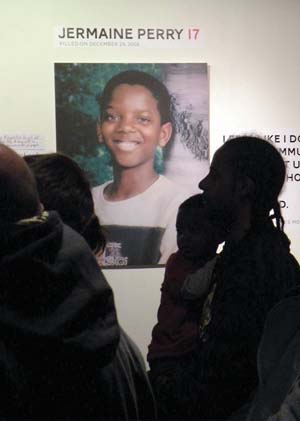November 10, 2011
 Anonymous Boston: Says Jerome Tevares, in silhouette, who lost his younger brother, Jermaine Perry, in December of 2008 in a shooting in Mattapan: “This exhibit is good for getting the word out. … but the problems we face are above this. It’s bigger than this."
Anonymous Boston: Says Jerome Tevares, in silhouette, who lost his younger brother, Jermaine Perry, in December of 2008 in a shooting in Mattapan: “This exhibit is good for getting the word out. … but the problems we face are above this. It’s bigger than this."
In the wake of a homicide, reporters track down and interview family members still coming to terms with their sudden loss, ask for photos of the deceased, and then write a story that is part obituary, part police report.
While the interview is oftentimes a tearful process, the first of many eulogies a mother, father, brother, or sister must recite, the real shock can come the following day when that family sees their loved one’s name online running alongside unconfirmed allegations of wrongdoing and a string of anonymous, hurtful comments left by readers who have never had to bury their child.
In hopes of showing both members of the media and the public how homicide coverage and the ensuing comments impact the families of victims, reporters and artists gathered last Friday at an art gallery in Kenmore Square for the unveiling of a new exhibit, “Anonymous Boston,” which highlights the lives of young men and women lost to street violence.
The exhibit’s producer, Joanna Marinova Jones, works with a number of Dorchester and Mattapan teens as a mentor with Press Pass TV, which trains city teens on how to produce their own video reports.
“What got me started was the way media coverage was impacting the way kids were looking at their neighborhood and themselves,” Marinova said. “They stopped seeing their neighborhoods as a place of opportunity and growth, but as a place to get away from.”
Marinova Jones said that change, coupled with the media circus following last September’s quadruple homicide in Mattapan, which evoked highly negative online comments directed toward a young mother and her son who were among the victims, moved her to tackle coverage of what she calls “journalistic graffiti,” hurtful and often outright racist comments posted at the end of news stories about murders and neighborhood violence on many of Boston’s media websites.
The exhibit includes a series of portraits detailing the lives of homicide victims and their families’ struggles in the wake of their loss displayed alongside comments left by online readers blaming parents for raising their children in tough neighborhoods or, in the case of 14-year-old Jaewon Martin, that the victim “got what they deserved.”
Jaewon’s mother, Nicole, said that her son’s age and reputation as a promising student- athlete protected his memory from accusations of gang ties in the paper following his death on Mother’s Day in 2010. But that did little to stop a wave of commentators from speculating about how her child found himself in the line of fire.
“It hurts,” Martin said as she reviewed a multimedia installation that included the Boston Herald article detailing her son’s death . “They told me not to go online, but I did anyway. People claimed that I was on welfare, that my son was probably in a gang. I explained that I never received a handout, that I worked for years, but even if I hadn’t, no one deserves to have this happen to their children.”
Exhibit photographer Ernesto Arroyo said the nine-month-long project is far from a solution to the problem, but rather a way to begin a new conversation about how and why homicides are pursued so doggedly for several days, only to be left on the wayside following a new act of violence.
“In talking with these families, after being invited to their homes, the question we kept coming back to was why the media report the way they do, why communities react the way they do, sometimes acting like these things aren’t happening on their own blocks,” Arroyo said. “It’s not one person, there’s no Doctor Evil behind all this. In the end it’s a failing system that we all need to take a hard look at if we ever hope to make things better.”
Arroyo was not alone in his call for a review of how Boston as a whole approaches the difficult issue of street violence and how it is presented to the public.
Jerome Tevares lost his younger brother, Jermaine Perry, in December of 2008 in a Mattapan shooting. The following day, Tevares read a Herald article describing his brother, who he said had no connections to any criminal groups, as a “suspected gangbanger, blasted to death in a hail of bullets on his Mattapan doorstep.”
“This [exhibit] is good for getting the word out, it’s helped my mom as a coping mechanism, but the problems we face are above this,” Tevares said. “It’s bigger than this and we are all a part of it.”
“Anonymous Boston” will be on view through Sat., Nov. 19 at Fourth Wall Project, 132 Brookline Ave., in Boston’s Kenmore Square/Fenway neighborhood. Gallery viewing hours are Wednesday through Sunday, 1-7pm. See anonymousbostonproject.com for more information.



